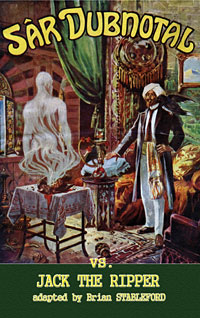 Sar Dubnotal is an early “occult detective,” like John Silence, Carnacki and others, who appeared in 20 anonymously written novellas published in France starting in 1909.
Sar Dubnotal is an early “occult detective,” like John Silence, Carnacki and others, who appeared in 20 anonymously written novellas published in France starting in 1909.
He’s called the “Great Psychagogue,” a term that means one who speaks with the dead.
The stories appeared in the French equivalent of the pulp magazines and were hastily dashed off with little planning or revision.
Black Coat Press has revised Sar Dubnotal as a character used in several stories in the “Tales of the Shadowmen” series. And they finally put out a collection of original Sar Dubnotal stories, “Sar Dubnotal vs. Jack the Ripper.”
Each of the novellas were independent stories, but there was a sequence running from the seventh through 11th stories that had Sar Dubnotal go up against “Jack the Ripper,” really his foe Tserpchikof, Lord of Crime, Master of the Chessmen.
The volume from Black Coat includes the first Sar Dubnotal story, as these characters first appear there. Then the seventh, ninth, 10th and 11th stories. The eighth story could not be found, but since it was summarized in the next story, its absence is not a problem.
In the first story, set in Breton, we met Sar Dubnotal and his associates. There is Rudolph, his disciple, a European youth he rescued from gypsies and is teaching his knowledge. Gianetti Annunciata is an Italian medium who helps him in communicate with the beyond. Naini is his Hindu servant. And there is a trio of researchers/detectives Frank (an Englishman), Frejust (a Frenchman) and Otto (a German).
For some reason, Sar will use the alias of Severus el Tebib (though why is never really explained).
In the first story, Sar and associates deal with a haunted house, owned by Countess Azilia, where her husband and father-in-law died. We learn that the countess murdered her husband and father-in-law, and caused her stepson to be disinherited. She foolishly left behind the murder weapon used to kill her husband and is exposed. Toward the end, we learn she is connected with a mysterious Russian, Tserpchikof. The countess is sent into exile at the end of the story.
The second story picks up from there, where Sar’s Hindu manservant Naini, who was escorting the countess, into exile, is found dead! But it turns out he is just comotose, and Sar and associates must prevent an autopsy, else he will die. But they are almost killed in a train wreck. They soon figure that Azilia was freed by Tserpchikof, and they start their search. They soon discover the pair in London operating as a fraudulent mystic and his assistant. Azilia is sent off into exile again, but Tserpchikof escapes.
 In the next story (missing but summarized in the following story), we learn there is more to Tserpchikof. He is actually a “Lord of Crime,” leader of a criminal network called The Chessmen, where the members are given names of chess pieces. Tserpchikof is the King, others are Knights and Pawns.
In the next story (missing but summarized in the following story), we learn there is more to Tserpchikof. He is actually a “Lord of Crime,” leader of a criminal network called The Chessmen, where the members are given names of chess pieces. Tserpchikof is the King, others are Knights and Pawns.
Next, a young lady is horribly killed, then her body is stolen from the morgue. Sar and associates discover that she was the Queen of the Chessmen, jealous of Azilia, and was killed by Tserpchikof, who also steals her body.
The climax occurs in the next story, set in London, where Sar tracks down Tserpchikof. It is discovered that he is also Jack the Ripper (whose attacks occurred a year or so before the setting of the story). Tserpchikof is quickly (almost too quickly) dispatched at the end of the story.
The final story serves as an epilogue. We return to Azilia, who has spent several years in exile on an island controlled by Sar Dubnotal called Redemption Island. She will be released and returned to France to be re-united with her two daughters. But she is plagued by the evil spirit of Tserpchikof. This closes out the story arc.
There is a fairly long introduction/background article by Brian Stableford (who “adapted” the stories, which usually means he didn’t do a straight translation, but did some cleanup work) on the character and the “occult” background of the times that may have influenced his creation.
As an added bonus, the covers of the original stories were included as section breaks, and the cover of the final story is used as the cover of the book, the other four being included on the back in “postage stamp” sizes.
Footnotes throughout the text point out some of the issues in the translation. Sadly, the work is marred by a larger than normal amount of typos and punctuation mistakes (as compared to other books I’ve gotten from Black Coat Press).
Since Sar Dubnotal is in the public domain, he has been used in the various Tales of the Shadowmen collections from Black Coat Press, as well as being included in the Doctor Omega and the Shadowmen volume. For more information on the character, check out the Cool French Comics website, as well as Black Coat’s first “Shadowmen: Heroes and Villains of French Pulp Fiction” book, which collects from that site plus their “French Wold Newton” site.
I doubt we will get any further original Sar Dubnotal stories, but new ones should appear in Tales. I look forward to that, as I’ve been enjoying the new stories (more so than the original ones). If you like occult detectives, check out this character.



